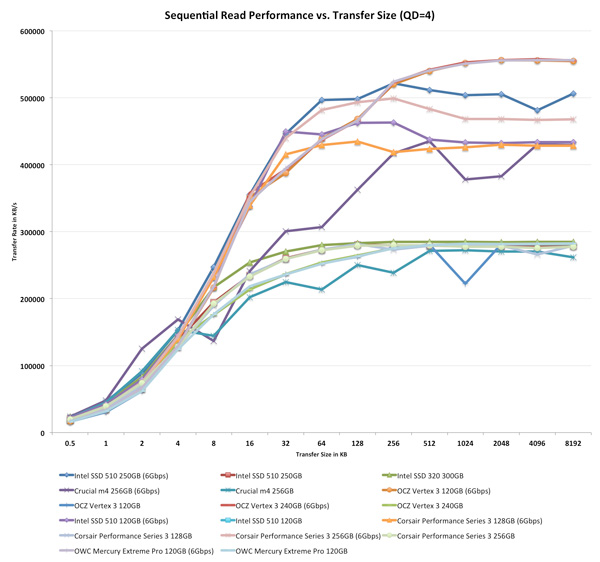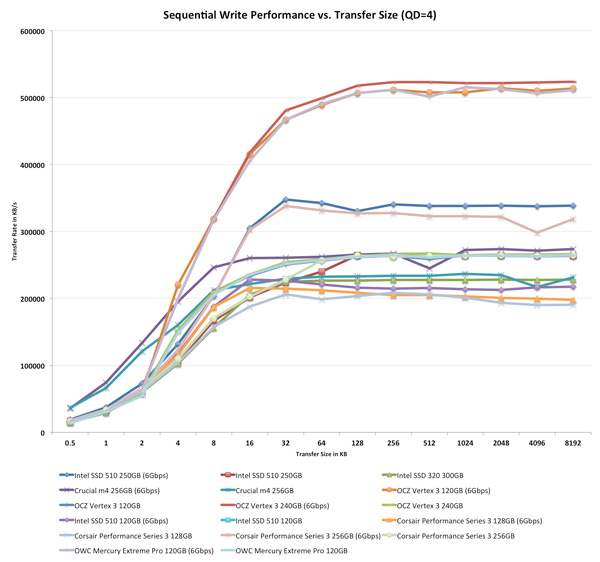OWC Mercury Extreme Pro 6G SSD Review (120GB)
by Anand Lal Shimpi on May 5, 2011 1:45 AM ESTPerformance vs. Transfer Size
All of our Iometer sequential tests happen at a queue depth of 1, which is indicative of a light desktop workload. It isn't too far fetched to see much higher queue depths on the desktop. The performance of these SSDs also greatly varies based on the size of the transfer. For this next test we turn to ATTO and run a sequential write over a 2GB span of LBAs at a queue depth of 4 and varying the size of the transfers.












44 Comments
View All Comments
Concillian - Thursday, May 5, 2011 - link
This is why I won't buy a SandForce SSD. Yeah, I can get a brand that doesn't have a cap. Or I can go with a different SSD that doesn't force me to jump through hoops to make sure I'm the same hardware from the right vendor.
The same hardware from different vendors should not have vastly different performance. How many people would put up with a memory bandwidth limit on P67 chipset motherboards from Gigabyte, but not ASUS? (or whatever brands.) No memory bandwidth doesn't have a huge impact on overall PC performance, but I think it would still be a big deal if something like that actually happened.
The SF-2281 either needs all vendors capped or none. It's a really shady tactic to offer two versions of the same hardware IMO.
semo - Thursday, May 5, 2011 - link
Nobody in the know likes the SF games but the whole thing is so complicated that most people won't understand it. Suits OCZ as the recent bad publicity doesn't seem to have affected them and everyone thinks they are the best choice for SSDs.Where are the Corsair force GT drives? Also, why are there no reviews of the Samsung 470?
Mr Perfect - Thursday, May 5, 2011 - link
I agree. If you want to offer vendors special products, fine, but give them a different model number. Call a controller capable of 27k a 2280 and the 52k version the 2281. You can still have incentive products, but the consumer doesn't get duped. Everyone's happy.Flunk - Thursday, May 5, 2011 - link
Almost all IC vendors do this. Intel is probably the worst by far. Selling essentially the same chip up to 50 different ways but lasering off parts of it. Almost all onboard sound chips, network chips, drive controllers, GPUs and anything else you can think of uses the same strategy.Chloiber - Thursday, May 5, 2011 - link
So the huge IOPS are pretty much useless, if the QD needs to be high - which is the case with every SSD.Anand, how is the "burst" rate of the Mercury regarding Random Write IOPS? I remember that with SF 12xx, the burst rate was exactly the same (for some seconds), only after 5-20s you could see a difference between the "unlocked" Vertex 2 and the rest. Considering how often one needs the random write performance for several seconds or even minutes (= never) I still think those huge IOPS numbers and the "unlocked firmware" stuff are just a huge marketing stunt. The benefit for the "normal" home user is = zero.
semo - Thursday, May 5, 2011 - link
Why is a high IOPS figure useless? Just because average Joe facebook doesn't do continuous IO intensive operations doesn't mean we don't need fast SSDs. You can apply your "logic" to CPU, GPU and pretty much any other technological advancement.kmmatney - Thursday, May 5, 2011 - link
For the normal home user, the Anand light workload test is really the best thing to look at - no need to look at any other metric. The drive does really well here.Robear - Thursday, May 5, 2011 - link
I believe most people who are interested in the power consumption are most interested in how it performs in a notebook. 2W versus 7W in power is negligible on a desktop. Instead of using a Velociraptor, can you please compare the SSD to a notebook hard drive, like maybe a Seagate Momentus?krazyderek - Thursday, May 5, 2011 - link
the momentus XT is included, the XT was a little more power hungry then typical notebook drives, have a look at the past review for more info to comparehttp://www.anandtech.com/show/3734/seagates-moment...
looks like some the new round of SSD's forgo power savings to move up the performance latter (ie: 240gb OCZ V3)
mschira - Thursday, May 5, 2011 - link
I was wondering if one could fit this drive into a 7mm slimline slot such as the Lenovo T420s.Lenovo only offers an Intel 160gb drive but I would fancy the possibility to insert a speedier 240gb SSD. maybe when removing some of the casing?
cheers
M.